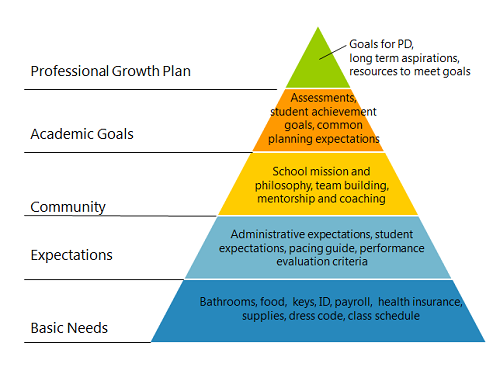You are here
Onboarding Guidance
The Unbreakable Connection Between Climate, Culture and Educator Recruitment and Retention
-
Your collective climate and culture are a direct reflection of your district. Everything you do is either attracting top talent; or driving it away.
-
Effective educator recruitment/retention can no longer be viewed as a “January to May” endeavor. It requires an intentional, year-round focus.
-
The more you can involve not only your school community, but also your entire community in these efforts, the greater the likelihood of retaining your staff.
-
As you maintain a clear focus on recruitment and retention, your climate and culture will only improve, which will improve educator recruitment and retention.
Strong Leadership: The #1 Reason Why Educators Stay
-
Always keep the journey of your new hires in mind, from the moment of offer/acceptance to their first day.
-
Creating the right connections and building relationships before the new hire arrives for pre-service is crucial. If possible, include new hires in end-of-year activities and other summer events with staff and the community.
-
Maintain strong mentoring and induction programs. Individualize new-hire professional development. Use distributive leadership to empower new staff. Allow them to lead professional development efforts.
-
New hires are watching their school/district leaders: Address staff who seek to undermine your positive climate and culture efforts, or you risk losing your top talent.
Effective Onboarding: A Graphic for What to Consider
(Source: The New Teacher Project)
Be Careful to Avoid the “Binary Fit Fallacy”
-
The binary fit fallacy implies that a new hire is either a “good” or “bad” fit. There is no in between.
-
The new hire will either fit in due to who they are, or they won’t.
-
A binary mindset advocates that it is pointless to follow an intentional onboarding process.
-
A binary mindset advocates that once the contract is signed, there is nothing a district can do to increase the new hire’s chance of success in the new role; if new hires are a bad fit, it’s on them.
-
A binary mindset excuses poor onboarding practices because the administrator already has an excuse prepared: “The new hire just wasn’t a good fit.”
-
And it allows administrators to neglect their responsibility to spend quality time with new hires.
-
A binary mindset leads to a vicious loop: “The last new hire didn’t work out. So why should I spend any time with new hires?”
-
Productivity, retention and culture will suffer due to ineffective onboarding.
From Onboarded, by Brad Giles
Onboarding is your overall system/process while terms such as “induction, orientation, training” are all adjacent to onboarding. A quick synopsis of what effective onboarding processes:
1) The Offer Letter
-
The letter should be enthusiastic and come from someone the candidate has already met.
-
It should outline specific skill sets and added value the new hire will bring to your district.
-
New hires will have questions: Be responsive, proactive, reach out!
-
Create an onboarding tool kit that outlines what new hires can expect.
-
People who receive a highly effective offer letter are 17 times more likely to feel connected to their organization.
2) Pre-boarding
-
Save time and effort with online/digital forms and e-signature software. Studies suggest you can save up to 40 hours/week by using digital forms and e-signature platforms.
-
Younger generations of workers expect to complete these tasks digitally, not via pen and paper.
3) District Culture and Policy Training
-
This is your one opportunity to establish what you’re about with your new hires: your culture, mission, values, and expectations. It is your opportunity to showcase your human side. Use humor! Make it fun and interactive.
-
New hires who receive effective, positive culture and policy training are 12 times as likely to feel committed to their district as opposed to those who are poorly trained. Eighty-nine percent feel a strong cultural integration versus 59% who are poorly trained. Ninety-one percent feel very connected to their organization versus 29% who are poorly trained.
4) Benefits Training
-
The research is clear: Comprehensive benefits training leads to increased retention. New hires who undergo effective, positive benefits training: 70.3% use their benefits more consistently and thoroughly as opposed to 26.6% who are poorly trained.
-
Happy, healthy employees tend to stick around. Medical benefits and insurance can be complicated matters. Spend plenty of time with new staff to fully inform them of everything you have to offer.
5) Create and Utilize Effective Onboarding Teams
-
Effective introductions are key. Connect new hires with your best people. Of employees who received highly effective onboarding experiences, 99% received introductions to key people. And 99% participated in some sort of “getting to know you” staff activity.
-
Who should be on your onboarding team? Three to five staff members who represent the mission, values, and culture of your district. These should be your educator cheerleaders.
WHERE CAN I LEARN MORE?
Please contact CDE’s Educator Recruitment and Retention (ERR) Office: educator_recruitment@cde.state.co.us
You may also contact one of the regional ERR representatives: https://www.cde.state.co.us/educatortalent/err-regions
Credits and Additional Resources Below:
The New Teacher Project (TNTP) – New Teacher Onboarding and Cultivation
Onboarded by Brad Giles
Bamboo HR – The Definitive Guide to Onboarding; More Definitive Guide to Onboarding




Connect With Us




